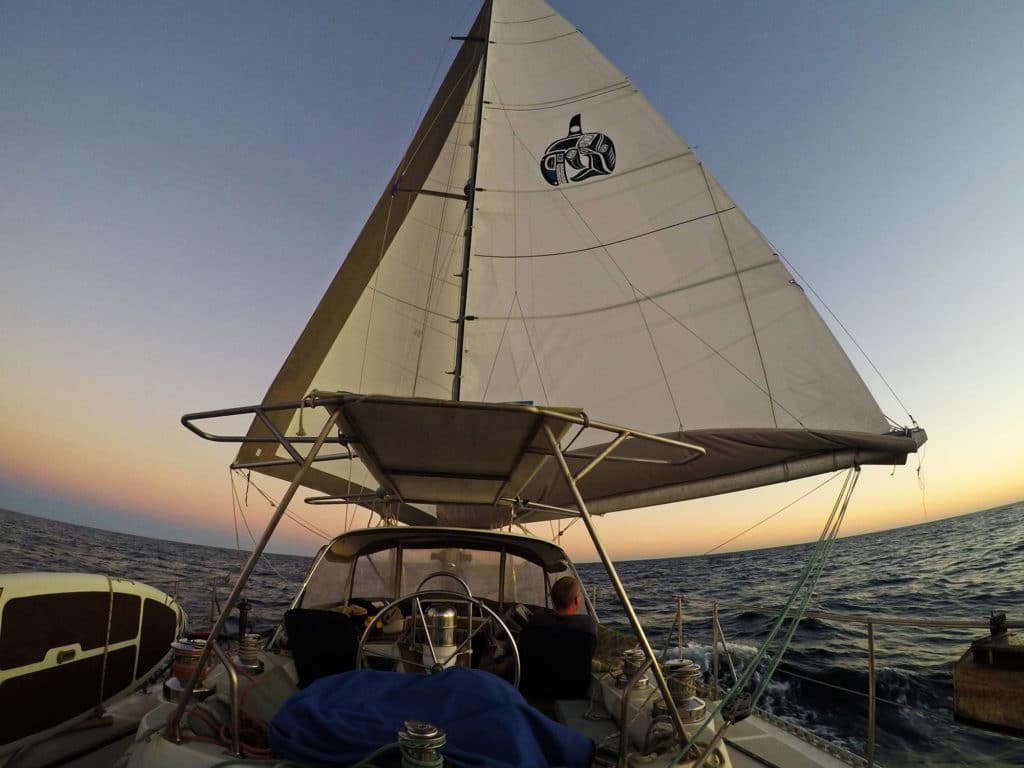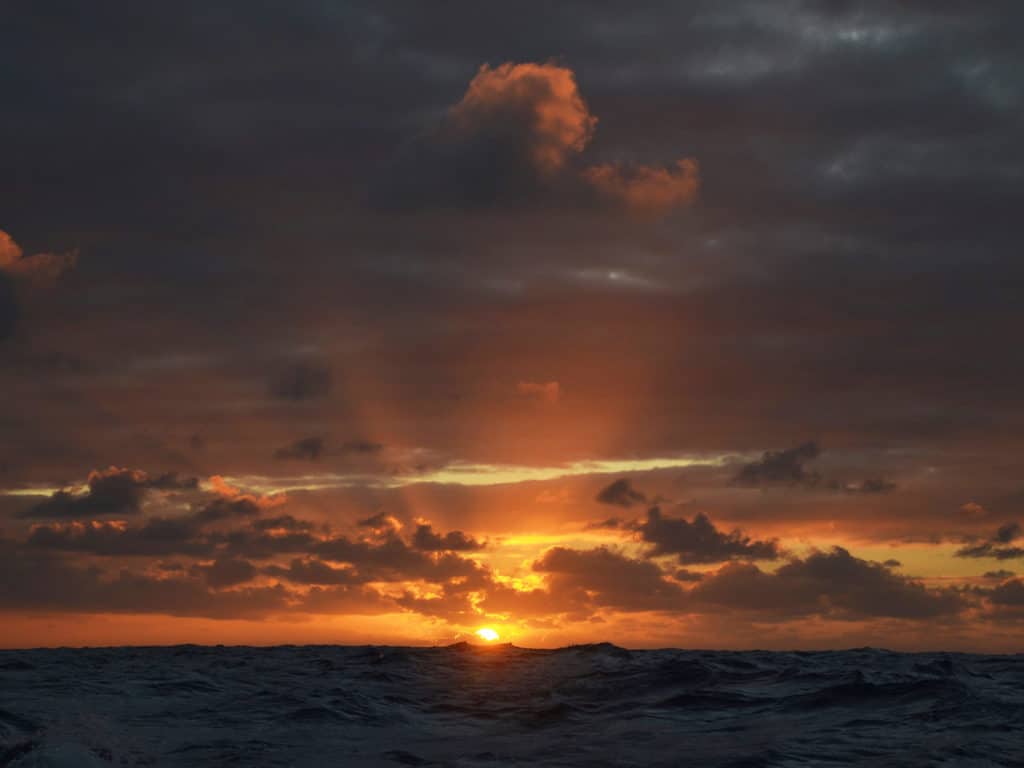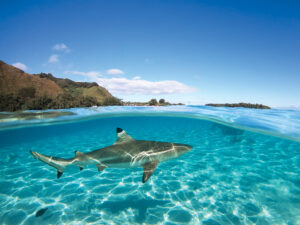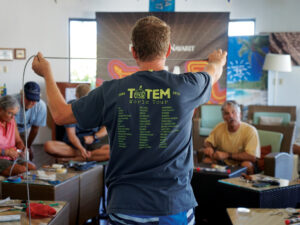
The Cabrales Boatyard’s crew blocks Totem up on the hydraulic trailer in preparation for our move from work yard to Travelift slings. The boards they press sound a call through the hull: we’re going soon! It’s almost time! I feel and hear their work from the main cabin while stowing an explosion of provisions into some semblance of organization.
After a flurry of activity, we are nearly poised to launch after more than two months in the shipyard. On Monday, we anticipate a splash-and-dash to get in the water and sail south. This time of year, the dominant weather feature is northers—systems starting around the Four Corners region, which send cold northerly winds driving unpleasant seas to the Sea of Cortez. All five of us are excited to get underway: Niall has craved sea time since we picked him up at his college campus nearly a month ago. “We’ve picked out our movies!” the girls announce; it’s their passage tradition to have a series marathon or favorites queued. PFDs and tethers lie waiting for use, laid out on the settee; the forecast reassessed with each update. Our e-readers are loaded with fresh books, the cache of snacks is ready, and my stash of night-watch-chocolate is at hand.
You might think major passage preparations were taking place; you’d be mistaken. In fact, this was prep for only two nights at sea. But it’s emblematic of two things: first, that our crew sorely craves putting miles under the keel, and is as fired up about this relatively short journey as we would a longer passage. Second, that there is no “only a couple of nights” pass on preparation, and that traditions often stem from the value in consistency of that prep. As I tucked my 92% dark (inky, bittersweet perfection) into the pantry for my midnight watch slot, the routines in keeping watch come back—sometimes with sentimental hues.
Keeping Watch
Watchkeeping routines are muscle memory for our crew. Transitioning on, the outgoing watch shares a status report on boat, crew, conditions, and any hazards. It’s also the moment to assess each other for tiredness or fatigue. During night watch change, we ease the transition, helping each other by putting on the kettle.
Eyes: Your Best Nav Tool
On-watch crew performs a visual 360° scan every 10 to 15 minutes on a typical watch. But if there are hazards nearby, traffic, or unsettled weather, the frequency increases, and may simply require constant attention. It’s astonishing how the binoculars we rely on for daytime use can also gather light at nighttime.
Being Mindful
Starry nights at sea can be magical, but they can also be stressful. Some senses are impaired, and it’s riskier to move around. Most important to remember: eyes take time to adjust to low light. Visual 360° is best done before checking radar and chartplotter impair eyesight. Off Sri Lanka, a fleet of tiny wooden fishing boats defeated all but the eyeballs. On an inky night near Baja the groan of an unlit panga was the first cue to fishermen nearby. I shone a flashlight on our mainsail to help make our presence as obvious as possible to the little fleet, which garnered the occasional flash in return—one mariner to another, the silent “hello, I see you!” returned.
Avoiding Fatigue
Fatigue is the enemy! Keeping rested is a priority. If crew aboard is prone to seasickness, pre-medicating is our standard. A sick crew is more than being one person down: they take the time and effort of healthy crew for their care, growing impact. On multiday passages, we sleep as much as we can during the day—forcing naps as needed—until the new biorhythm is established. It’s short jaunts like this one that are the hardest. I typically wake up the third day ready to be on passage “forever!” after a couple of foggier days coping with the change in sleep routine.
Safety Equipment
We follow common-sense rules for personal safety, which lead to the primary goal of staying ON the boat. At night and during moderate to rough weather any time of day, wear PFD, safety tether, and other safety gear as per the setup onboard the boat. If there’s a need to leave the cockpit, always alert another crew first.
Being Aware
Good watchkeeping is about being ready, being alert and responding quickly if necessary. But watchkeeping can also be the space between busy and occupied, then you can let your senses refocus to the sounds and smells and sights of the natural world around you with utter impunity: it is careful attention to these three that are at the core of the task. Listen: is that a pump running? Smell: is something burning? See: is that a planet or a navigation light on the horizon?

Watch Schedule
Sharing our watch schedule is almost an afterthought, because it’s not exactly a schedule. It’s more of a routine. A pattern we’ve found over time, one that works with our biorhythms. Daytime is organic: if you’re tired, SLEEP. Tell the other person you are off, and roll with what your body needs. We have dinner as a family around sunset, and I crash afterwards, because I can. Jamie gets tired later in the evening, so by 10 or 11—I’m on watch. I’ve never done well during the wee hours of the morning, and when I feel that tug—around 2 or 3—I nudge Jamie to relieve me. He takes over and has the magical sunrise watch, and I’m relatively fresh when woken by the sun. This doesn’t translate well to graph paper, but it works well for us.
To the uninitiated, sailing at night could seem like driving through New York city on Friday night while jet lagged during a city-wide power outage. It’s not really like that, 99% of the time. Mostly it’s like being on a long stretch of open highway, without towns to rest and repair in. Stay on the road, awake while driving, and slow when conditions require—you’ll reach your destination feeling good about the journey.
2021 Planning
What’s ahead for cruising in 2021? A few months back I spent time interviewing cruisers around the globe to better understand regional differences in experience, as indicators for how they may handle the alternating surges and retreats of COVID in the months ahead. The output of the that research and the insights gleaned is now online at Cruising World: read The Outlook for Cruising in 2021.
Major Blog Update!
A few days ago, our rock star web consultant, River Braun, moved Sailing Totem to a new platform. The transition was great—the fine tuning will take time (turns out, I have a lot of blog posts and everyone needs some TLC to make the shift). If you find a broken link, please let me know. And meanwhile, check it out! I hope you like the new look.








